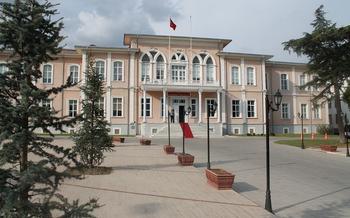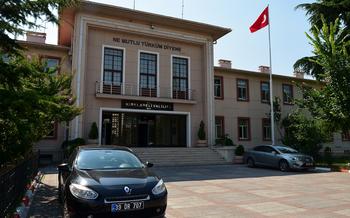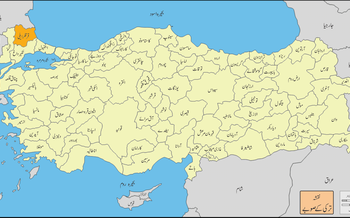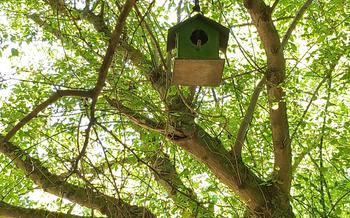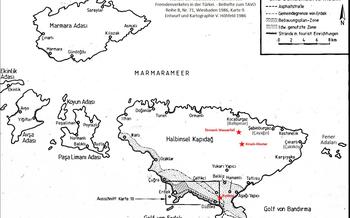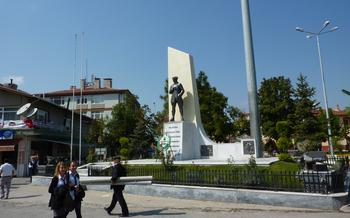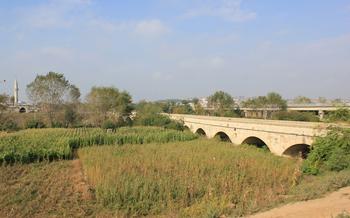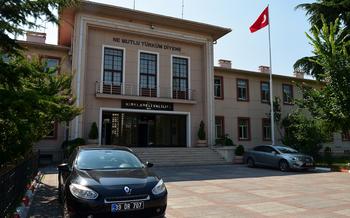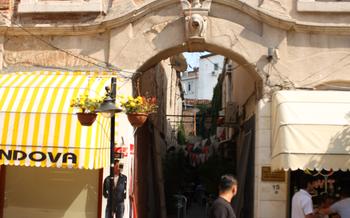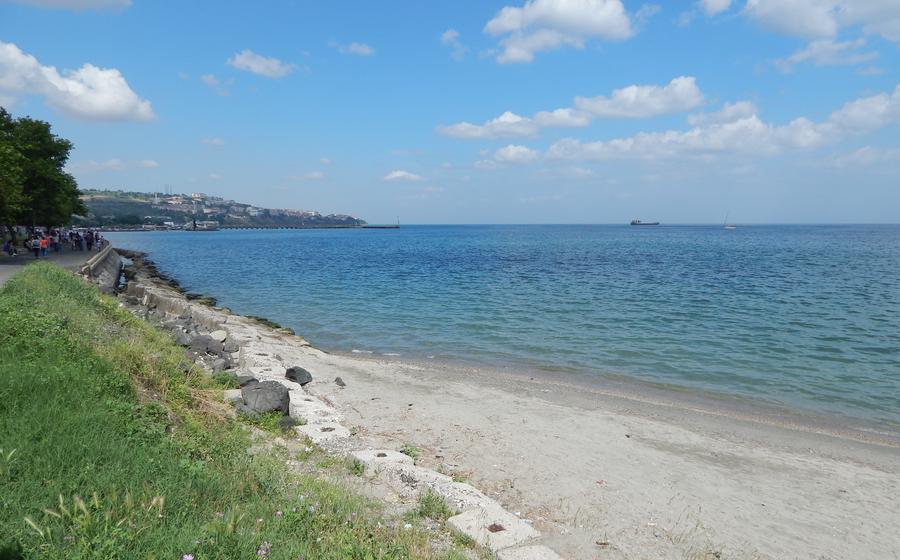
Kırklareli Museum (nearby city)
- A Journey to Tekirdağ and Kırklareli: Unveiling the Thracian Treasures
- The Kırklareli Museum: A Haven of History and Cultural Heritage
- Thrace: A Crossroads of Civilizations
- Historical Highlights of Tekirdağ and Kırklareli
- Must-See Exhibits at the Kırklareli Museum
- Exploring the Thracian Cuisine
- Off-the-Beaten-Path Gems in Tekirdağ and Kırklareli
- The Warmth of Thracian Hospitality
- Exploring the Thracian Wine Route
- The Enchanting Landscapes of Tekirdağ and Kırklareli
- Shopping for Local Treasures in Tekirdağ and Kırklareli
- Capturing the Essence of Thrace Through Photography
- Insider Tip: Discovering Hidden Gems Beyond the Museum Walls
A Journey to Tekirdağ and Kırklareli: Unveiling the Thracian Treasures
As a travel blogger with a passion for history and culture, I embarked on a captivating journey to Tekirdağ, a charming city in northwestern Turkey, and its neighboring city, Kırklareli. My primary goal was to delve into the rich tapestry of the Thracian region, renowned for its historical significance and cultural heritage. The Kırklareli Museum, a treasure trove of Thracian artifacts, beckoned me with the promise of an immersive experience.
The drive from Tekirdağ to Kırklareli was a visual delight, offering glimpses of the region's stunning landscapes. Rolling hills adorned with vineyards, lush forests, and sparkling rivers painted a picturesque backdrop to our journey. As we approached Kırklareli, a sense of anticipation filled the air, fueled by the tales of Thracian history that had captured my imagination.
Visiting the Kırklareli Museum was a pivotal moment in my journey. As a history enthusiast, I was eager to explore the museum's diverse collection of artifacts, each whispering stories of civilizations past. The Thracian region, a crossroads of cultures, bore witness to the rise and fall of empires, leaving behind a tangible legacy that I was eager to uncover.
The allure of Thrace had always captivated me. Its unique blend of Greek, Roman, Byzantine, and Ottoman influences promised a journey through time, where the echoes of ancient civilizations still resonated. I couldn't wait to immerse myself in the region's rich tapestry and unravel its many secrets.
The Kırklareli Museum: A Haven of History and Cultural Heritage
The Kırklareli Museum stands as a guardian of Thracian history, its walls whispering tales of ancient civilizations and bygone eras. Within its hallowed halls, a diverse collection of artifacts awaits the curious explorer. Ancient pottery, intricately carved sculptures, and weathered inscriptions narrate the story of a region steeped in cultural heritage. Each artifact, a tangible link to the past, beckons visitors to delve deeper into the rich tapestry of Thracian history.
The museum's mission is not merely to showcase these treasures but to breathe life into the stories they hold. Through interactive displays and informative panels, visitors are invited to engage with the past, to understand the significance of each artifact, and to appreciate the enduring legacy of the Thracian people. The museum's commitment to preserving and showcasing the region's cultural heritage ensures that future generations can connect with their roots and gain a deeper understanding of their identity.
One artifact that particularly captivated my attention was a delicately crafted gold pendant, adorned with intricate Thracian motifs. Its exquisite workmanship and symbolic significance spoke volumes about the artistry and craftsmanship of the ancient Thracians. As I gazed upon it, I couldn't help but imagine the hands that had created it, the stories it had witnessed, and the journey it had undertaken to find its home within the museum's walls.
Thrace: A Crossroads of Civilizations
Thrace, the land that bridges the continents of Europe and Asia, has long been a crossroads of civilizations. Its strategic location has attracted various cultures throughout history, each leaving an indelible mark on the region's cultural tapestry.
From the ancient Greeks who established colonies along the coast to the Romans who brought their architectural prowess, Thrace has witnessed the rise and fall of empires. The Byzantines left their legacy in the form of magnificent churches and monasteries, while the Ottomans, who ruled the region for over five centuries, contributed their unique blend of Islamic and Turkish influences.
This convergence of cultures has resulted in a rich and diverse cultural heritage that is reflected in the region's architecture, cuisine, music, and traditions. Thrace is home to a fascinating mix of languages, with Turkish, Greek, Bulgarian, and Armenian being spoken in different parts of the region.
One of the best ways to experience this cultural diversity is to visit the local markets and bazaars. Here, you can find a vibrant array of traditional crafts, handmade textiles, and local delicacies that showcase the region's rich heritage.
In my travels through Thrace, I had the privilege of meeting a local historian who shared with me his insights into the region's diverse heritage. He explained how the different cultures that have inhabited Thrace have influenced everything from the region's cuisine to its music and dance.
He told me about the ancient Thracian rituals that are still practiced in some villages, and how the region's unique blend of languages has given rise to a rich oral tradition of storytelling and poetry. Through his stories, I gained a deeper appreciation for the cultural tapestry of Thrace and the enduring legacy of the many civilizations that have shaped its history.
Historical Highlights of Tekirdağ and Kırklareli
Tekirdağ and Kırklareli, nestled in the heart of Thrace, have witnessed a rich tapestry of historical events that have shaped their unique identities. Tekirdağ, strategically located on the shores of the Sea of Marmara, served as a crucial trade center throughout history. In the ancient world, it was part of the powerful Thracian Kingdom, leaving behind a legacy of impressive archaeological sites. During the Byzantine era, Tekirdağ flourished as an important port city, connecting the empire with the Black Sea region.
Kırklareli, on the other hand, emerged as a significant center of cultural exchange and trade. Throughout history, it has been influenced by various empires, including the Greeks, Romans, Byzantines, and Ottomans. Each civilization left its mark on the city, contributing to its architectural heritage. From ancient Greek temples to Byzantine churches and Ottoman mosques, Kırklareli is a living testament to the region's diverse past.
The Ottoman Empire played a pivotal role in shaping the historical trajectory of Tekirdağ and Kırklareli. During this period, the region experienced economic growth and prosperity. Tekirdağ became a hub for viticulture, with its vineyards producing renowned wines that were exported throughout the empire. Kırklareli, on the other hand, flourished as a center of craftsmanship and trade, with its artisans producing exquisite carpets, textiles, and pottery.
My personal anecdote relates to a visit to the Tekirdağ Museum, where I had the privilege of viewing a remarkable collection of artifacts that brought the region's history to life. Among the exhibits, a well-preserved Thracian helmet particularly captivated me. Its intricate design and the story behind its discovery transported me back to a time when fierce warriors roamed these lands. It was a tangible reminder of the rich and storied past that Tekirdağ and Kırklareli hold dear.
Must-See Exhibits at the Kırklareli Museum
The Kırklareli Museum is home to a diverse array of captivating exhibits that showcase the rich history and cultural heritage of the Thracian region. Among the must-see exhibits is a collection of ancient pottery that dates back to the Neolithic period. These intricately decorated vessels provide a glimpse into the daily lives and artistic traditions of the region's earliest inhabitants.
Another highlight of the museum is the collection of sculptures, which includes both life-size statues and smaller figurines. These works of art depict a variety of subjects, from mythical creatures to historical figures, and offer a glimpse into the religious beliefs and artistic styles of the ancient Thracians.
Equally impressive is the collection of inscriptions, which includes stelae, tablets, and other inscribed objects. These inscriptions provide valuable insights into the languages, religions, and political systems of the ancient Thracians.
One exhibit that particularly captured my attention was a gold necklace adorned with intricate Thracian motifs. The necklace is believed to have been worn by a high-ranking official or religious figure and is a testament to the skill and artistry of the ancient Thracian goldsmiths.
These are just a few of the many remarkable exhibits that can be found at the Kırklareli Museum. Each artifact tells a story about the rich and vibrant history of the Thracian region, making the museum a must-visit for anyone interested in history, culture, and archaeology.
Exploring the Thracian Cuisine
The culinary delights of the Thracian region are a testament to its rich cultural heritage. Influenced by various civilizations throughout history, the local cuisine boasts a harmonious blend of flavors and fresh, seasonal ingredients. Must-try dishes include the savory Tekirdağ meatballs, known for their tender texture and aromatic spices. Kırklareli's famous keşkek, a hearty wheat and meat stew, is a testament to the region's agricultural roots. Sample the delectable stuffed grape leaves, a symbol of local hospitality, or indulge in the sweet temptation of sütlaç, a creamy rice pudding that will delight your taste buds. Each bite reveals the unique culinary tapestry of Thrace, where history and tradition intertwine to create a symphony of flavors.
In a small, family-run restaurant nestled in the heart of Tekirdağ, I had the privilege of savoring an unforgettable meal that showcased the essence of Thracian cuisine. The aromas wafting from the kitchen drew me in, and as the dishes were placed before me, I was captivated by the vibrant colors and enticing scents. The meatballs, perfectly seasoned and grilled to perfection, melted in my mouth, leaving a trail of savory delight. The keşkek, served in a traditional clay pot, was a labor of love, its rich and creamy texture enveloping my senses. As I savored each bite, I felt a deep connection to the region's history and the warmth of its people. The meal was not just a culinary experience but a journey through time and tradition, leaving me with a lasting appreciation for the Thracian art of cooking.
Off-the-Beaten-Path Gems in Tekirdağ and Kırklareli
Beyond the bustling cities and popular attractions, Tekirdağ and Kırklareli offer a treasure trove of hidden gems waiting to be discovered. Venture off the beaten path to uncover the region's natural beauty, charming villages, and unique cultural experiences.
Explore the picturesque town of Vize, nestled amidst lush forests and rolling hills. Wander through its cobbled streets, admire the traditional Ottoman architecture, and visit the historic Vize Kalesi, a medieval fortress that offers stunning panoramic views.
For nature enthusiasts, the Tekirdağ and Kırklareli regions are a paradise. Hike through the enchanting Ganos Mountains, home to diverse flora and fauna, and discover hidden waterfalls and secluded swimming spots. Cycle along the scenic Marmara Sea coast, enjoying the refreshing sea breeze and breathtaking views.
Uncover the hidden beaches of Tekirdağ, where you can escape the crowds and relax in tranquil surroundings. Swim in the crystal-clear waters, sunbathe on the golden sands, and enjoy the serenity of these secluded havens.
Immerse yourself in the local culture by visiting traditional villages like Kıyıköy, where you can witness traditional crafts, sample delicious homemade cuisine, and experience the warmth of Turkish hospitality.
Don't miss the opportunity to explore the region's rich history by visiting ancient ruins and historical sites that lie hidden amidst the countryside. Discover the remains of ancient civilizations, marvel at well-preserved mosaics and frescoes, and let your imagination transport you back in time.
Remember, the most rewarding experiences often lie beyond the main tourist routes. Embrace the spirit of adventure, ask for recommendations from locals, and be open to unexpected discoveries as you explore the hidden gems of Tekirdağ and Kırklareli.
The Warmth of Thracian Hospitality
The people of Thrace are renowned for their warm hospitality and take great pride in sharing their heritage with visitors. As I ventured through the region, I was consistently met with smiles, friendly greetings, and invitations to share a cup of tea or join in local festivities.
One particularly memorable experience occurred in a small village nestled amidst rolling hills. As I wandered through the cobblestone streets, admiring the traditional Ottoman-style houses, I was approached by an elderly woman who invited me into her home for a traditional Turkish coffee. As we sat together, sipping our coffee and sharing stories, I felt a genuine connection to this woman and her deep love for her homeland.
This encounter reminded me of the importance of interacting with locals to truly immerse oneself in the culture of a region. By embracing the hospitality of the Thracian people, I gained invaluable insights into their way of life and left with a profound appreciation for their warmth and generosity.
Exploring the Thracian Wine Route
The Thracian region is renowned for its ancient winemaking tradition, dating back to the days of the Thracian tribes who inhabited these lands. Today, the region boasts a thriving wine industry, with numerous wineries and vineyards producing a diverse range of vintages.
As a wine enthusiast, I couldn't resist the opportunity to explore the Thracian Wine Route. I visited several local wineries, where I was warmly welcomed by the passionate winemakers. They shared their knowledge about the unique terroir and grape varieties that contribute to the distinctive flavors of Thracian wines.
During my visit to one particular winery, I had the privilege of tasting a selection of their finest vintages. The wines were exceptionally well-crafted, showcasing a harmonious balance of fruit, acidity, and tannins. I was particularly impressed by a full-bodied Cabernet Sauvignon that exhibited notes of dark berries, spice, and a hint of oak.
In addition to sampling the delicious wines, I also learned about the history and culture of winemaking in the region. The winemakers shared stories about their families' long-standing traditions in viticulture and the challenges they faced in preserving the region's winemaking heritage.
Whether you are a seasoned wine connoisseur or simply enjoy a glass of wine with friends, I highly recommend exploring the Thracian Wine Route. It is an opportunity to discover the region's rich winemaking tradition, taste some of the finest vintages in Turkey, and meet the passionate people who are dedicated to preserving this ancient craft.
The Enchanting Landscapes of Tekirdağ and Kırklareli
Thrace is a region blessed with an abundance of natural beauty, from rolling hills and lush forests to pristine beaches and sparkling rivers. Tekirdağ and Kırklareli offer a variety of outdoor activities for nature enthusiasts, including hiking, cycling, and birdwatching.
One of the must-see natural attractions in the region is the Istranca Mountains National Park, a vast and diverse protected area known for its stunning scenery and rich biodiversity. Visitors can explore the park's many trails, which wind through forests, meadows, and along streams, offering opportunities to spot a variety of wildlife, including birds, deer, and even bears.
For those who prefer a more leisurely pace, the region's many beaches provide the perfect place to relax and soak up the sun. The beaches of Tekirdağ and Kırklareli are known for their clean waters and soft sands, making them ideal for swimming, sunbathing, and building sandcastles.
In addition to its mountains and beaches, the region is home to several rivers and lakes, which offer opportunities for fishing, boating, and kayaking. The Ergene River, which flows through Tekirdağ, is a popular spot for fishing and birdwatching, while Lake Gala, located near Kırklareli, is a popular destination for boating and swimming.
The natural beauty of Tekirdağ and Kırklareli is a reminder of the region's rich and diverse heritage. The stunning landscapes, diverse wildlife, and pristine waters are a testament to the region's unspoiled beauty and the importance of preserving it for future generations.
Shopping for Local Treasures in Tekirdağ and Kırklareli
When visiting Tekirdağ and Kırklareli, take the opportunity to immerse yourself in the region's rich cultural heritage by shopping for unique souvenirs and handmade crafts. Local markets and bazaars are a treasure trove of authentic products that reflect the region's vibrant traditions. From intricate carpets and ceramics to exquisite jewelry and textiles, there's something for every taste and budget.
Stroll through the vibrant Tekirdağ Market, where vendors display an array of goods, from fresh produce and spices to traditional Turkish delights. Here, you can haggle for the best prices and discover hidden gems that will make cherished keepsakes.
In Kırklareli, explore the charming Kırklareli Bazaar, where local artisans showcase their handmade crafts. From intricate woodwork and pottery to colorful textiles and traditional costumes, the bazaar offers a glimpse into the region's rich artistic traditions.
Before you embark on your shopping adventure, familiarize yourself with the local bargaining etiquette. While bargaining is an essential part of the shopping experience, it should be done respectfully and with a smile. Don't be afraid to ask questions and engage with the vendors, as they are often happy to share stories about their products and the region's cultural heritage.
As you wander through the markets, keep an eye out for unique souvenirs that reflect the region's history and traditions. Whether it's a hand-woven rug adorned with intricate patterns, a ceramic bowl painted with vibrant colors, or a piece of traditional jewelry, each purchase supports local artisans and helps preserve the region's cultural heritage.
So, embrace the vibrant shopping scene of Tekirdağ and Kırklareli, and take home a piece of the region's charm to cherish for years to come.
Capturing the Essence of Thrace Through Photography
The picturesque landscapes, vibrant culture, and rich history of Tekirdağ and Kırklareli provide a treasure trove of opportunities for photographers of all levels. Whether you're a seasoned professional or just starting, capturing the essence of Thrace through your lens is an unforgettable experience.
Embrace the Local Culture: Thrace is a region where tradition and modernity intertwine. To truly capture the essence of the place, engage with the locals, attend local events, and immerse yourself in their way of life. This will not only lead to stunning photographs but also create a deeper connection with the region.
Explore the Natural Beauty: Thrace is blessed with an abundance of natural beauty, from the rolling hills of the Tekirdağ Mountains to the pristine beaches along the Sea of Marmara. Take advantage of the region's diverse landscapes to create breathtaking images that showcase the region's natural wonders.
Respect Local Customs: When photographing people or religious sites, always ask for permission and be respectful of local customs and traditions. This not only shows respect for the local culture but also ensures that you have a positive and enriching experience.
Anecdote: During my visit to Tekirdağ, I stumbled upon a hidden gem – a traditional Turkish coffeehouse tucked away in a narrow alley. The warm glow of the copper coffee pots and the aroma of freshly brewed coffee filled the air. I couldn't resist capturing this moment, and the resulting photograph became one of my most cherished memories from the trip.
Insider Tip: Discovering Hidden Gems Beyond the Museum Walls
Beyond the walls of the Kırklareli Museum, Tekirdağ and Kırklareli offer a treasure trove of hidden gems waiting to be discovered. These secret spots, often overlooked by the average tourist, provide a glimpse into the region's rich history, vibrant culture, and stunning natural beauty.
One such hidden gem is the ancient city of Perinthos, located just a short drive from Tekirdağ. This once-thriving city, founded by Greek colonists in the 7th century BC, boasts impressive ruins that transport visitors back in time. Explore the remnants of its ancient walls, temples, and theater, and imagine the bustling life that once filled its streets.
Another hidden gem is the village of Kıyıköy, nestled along the Black Sea coast. This charming village, with its colorful wooden houses and cobblestone streets, exudes a timeless atmosphere. Take a leisurely stroll through its narrow alleys, visit the local fish market, and savor the freshest seafood delicacies at one of the many waterfront restaurants.
For those seeking natural wonders, venture to the Istranca Mountains, a vast and unspoiled wilderness that straddles the border between Turkey and Bulgaria. Hike through its lush forests, encounter cascading waterfalls, and admire the panoramic views from its mountain peaks.
Remember, when exploring beyond the main tourist areas, it's essential to respect local customs and traditions. Dress modestly, be mindful of your behavior, and ask permission before taking photographs of people or private property. The locals are proud of their heritage and will appreciate your efforts to engage with them respectfully.
Whether you're a history buff, a nature enthusiast, or simply seeking unique experiences, Tekirdağ and Kırklareli offer a wealth of hidden gems beyond the walls of the Kırklareli Museum. Embrace the spirit of adventure, venture off the beaten path, and discover the region's best-kept secrets.
